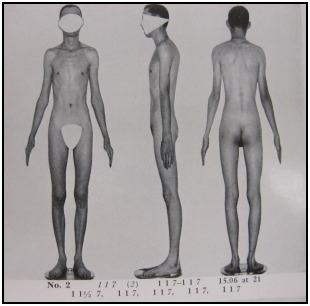Somatotype: What's Your Body Type?
Your 'Somatotype' is your body type. While there are around 6 billion people on earth, each one falls into one of the 3 types.
Weight training is one of the best methods of strength training! If you want to start weight training safely and effectively, with the best info, diet, and routines, check out the 5 Day Beginner Weight Training Course!
If you know your type you can better tailor your strength training and exercise routines to that type. And with some knowledge about the origins of this typing system, you can steer your way around many common misconceptions associated with different body types.
Where Did Somatotypes Come From?
During the 1940s, William Sheldon, an American psychologist, was interested in the link between body types and personality/mental functions. Thus, he started taking pictures of naked people.
From the 1940s until late in the 1960s Sheldon took nude photos of the entering freshman classes at Ivy League collages, with small pins located on their spines to emphasize their spine shape.[1] The students were told that this was done to study their posture, as one graduate noted…[2]
- "Those whose pins described a too violent or erratic postural curve were required to attend remedial posture classes."[3]
This research formed the basis for several books Sheldon wrote. The most influential one was Atlas of Men; A Guide For Somatotyping The Adult Male At All Ages, published in 1954. In Atlas of Men, Sheldon lays out his classification for the 3 Somatotypes, or body categories, into which all people fall to some degree.
The 3 Somatotypes
◆ Ectomorph: Long, thin muscles and bones and low body-fat percentage. Normally described as tall and thin.
◆ Mesomorph: Medium bone size, solid chest, doesn't have much fat, and gains muscle easily.
◆ Endomorph: Wide waist, shorter, puts on fat easily, usually referred to as chubby or fat. Typically has strong legs.

There are very few people who fall solely into one category, so Sheldon made a rating system from 1-7, laid out endomorph-mesomorph-ectomorph. This showed how much of each body type each person exhibited.
So, a pure endomorph would be 7 1 1, a pure mesomorph would be 1 7 1, and a person who was half mesomorph and half ectomorph (and no endomorph) would be 1 4 4. A nice, clean, systematic way of cataloguing all human body types.
So, Are These Body Types Reliable?
Not really.
And they're not genetically real.
It was a good first attempt at cataloguing body types. But Sheldon went further than that in Atlas of Men. He assigned people different personalities and mental attributes based on their body types, even using animalistic metaphors.
He claimed that ectomorphs, the 'thin & tall' body type, he says generally have lots of nervous energy. He contrasted this with mesomorphs, the 'muscular' body type, who are supposed to be excessively aggressive. He then goes into detailing the different mental makeups of people based on their scores (a 4 1 5 is weak and effeminate, etc.).
Here's an example of Sheldon's description of a pure ectomorph...

"1. Walking Sticks
"Somatotype 1 1 7(Polar ectomorphy, 9-level.) At the structural maximum in the third component, and at the minimum in the other two. The polar Southwest.4 Walking Sticks. Fragile stretched-out creatures with the utmost surface exposure in proportion to mass, and therefore with maximal delicacy of structure.
"Rarity 5 Incidence 2 per ten thousand. This extremely rare somatotype presents an almost perfectly flat curve of nutrition through out adult life and seems only by the barest margin to maintain the frailest, most brittle sort of human existence. The normal or mean weight gain during the period from early manhood to old age appears to be one a pound or two, at average stature. Such a person is often the despair both of mothers and the nutritionist. Under forced overfeeding, especially with food rich in butterfat, there may be a temporary weight gain of a few pounds but the new weight tends to remain in one place-usually as a derbylike protuberance of the lower belly-and this is inclined to disappear promptly when the subject returns to his normal or regular diet.
"…the 1 1 7 is more common in the mental hospitals than in the general population, and his diagnosis is usually hebephrenic schizophrenia. But also he is encountered more frequently on college campuses than in the general population, and there the diagnosis is sometimes Phi Beta Kappa. This occasional coincidence of sensitive brilliance and hebephrenic jettisoning is one of the things that make mental tests difficult to interpret, particularly when the somatotype is not known."[5]
Total pseudoscientific drek!
Also, Ivy League freshman are probably not a representative sample of the general population. Thus, Sheldon's observations may be skewed by that as well.
And Sheldon was not in a position to do any sort of genetic determination. The categories are based purely on sight.
Basically, much of his research is bunk and is no longer accepted academically.
However, this terminology does work as a method of describing your body type. You can say you are a 1 4 4, or an ectomorph-mesomorph hybrid, instead of saying, "Well, I'm pretty tall and skinny but I can also put on muscle."
What Your Somatotype Means For Your Training
As a general categorization of body types, these categories work. Accurately labeling your body type can generally guide your training in terms of losing weight and in knowing what bodily actions may be more difficult.
For example, if you are tall and skinny (ectomorph) then you'll probably have a harder time putting on muscle, and want to focus on that. If you're fatter (endomorph) and want to get ripped, you should try more cardio.
As if you were simply skinny or fat.
Change Your Body Type!
The big problem with Sheldon’s categories, though, is that he treats them as pre-determined and static. In reality, however, you are not sentenced to your fate by being predominately one type. Through diligent work you can change your somatotype.
A tall skinny person can, through a rigorous diet of cakes, pies, and doughnuts, become fat. Or work out a ton and become more muscular.
There are some genetic factors that do influence your success in strength training and bodybuilding. But you're stuck with them, so it's no use worrying!
It really isn't worth worrying whether you're too much of an endomorph or whatever. Just workout hard and use routines that address your issues (e.g. lifting heavy weights for a few repetitions to gain strength, lifting slightly lighter weights for 6 - 12 reps for bigger muscle size, etc.).
Oh, and be sure to sign up for the e-zine Starting Strong to get monthly strength training, exercise, and diet tips e-mailed to you - and access to the free e-book Train Smart, Eat Smart: Exercise Nutrition Hacks!
• Click here to learn more about Different Body Types!
OR
• Click here to leave 'Somatotype: What's Your Body Type?' & go back to the Home-page!
Somatotype: What's Your Body Type?
References:
1. Rosenbaum, Ron. THE GREAT IVY LEAGUE NUDE POSTURE PHOTO SCANDAL. The New York Times. < http://query.nytimes.com/gst/fullpage.html?res=990CE7D91131F936A25752C0A963958260&sec=&spon=&pagewanted=1 >.
2. Nude Photos of Yale Graduates Are Shredded. < http://select.nytimes.com/gst/abstract.html?res=F60612F739540C7A8EDDA80894DD494D81 >.
3. Rosenbaum, Ron. THE GREAT IVY LEAGUE NUDE POSTURE PHOTO SCANDAL. The New York Times. < http://query.nytimes.com/gst/fullpage.html?res=990CE7D91131F936A25752C0A963958260&sec=&spon=&pagewanted=2 >.
4. Referring to the triangular ecto-meso-endo graph Sheldon came up with.
5. Sheldon, William Herbert. 1954. Atlas of Men; A Guide For Somatotyping The Adult Male At All Ages. New York: Harper. Pp. 36.
Search CST...
|
Tweet Follow @Aaron_CST |
|
"About 2 weeks ago I read all the ab strengthening stuff on your site because I decided I wanted to be strong, instead of having a lot of belly fat. So I started eating healthier, running, exercising, you name it - everything your site said to do to help. Now I am noticing a real difference! Thank you for making this. :D xD" ~ Julia |
|
[This calorie calculator is] the most useful tool on the web that I can find… Also, I compared the calories calculated by your calculator to the calories calculated by the treadmill at my gym, and they're within a couple calories of each other, so yours is as accurate as we're going to get. REALLY AWESOME TOOL. I love it and depend on it. Thank you sooooo much for making this available." ~ Galit Sharon Marcus |
|
Thank you very much, I was too lean before 2 years (55 Kgs), after the gym now I'm 72kgs, all the muscles have developed... when someone hand shakes with me it can be squeezed easily, they're making fun of me! ~ Tamil Arasan |






New! Comments
Have your say about what you just read! Leave me a comment in the box below.